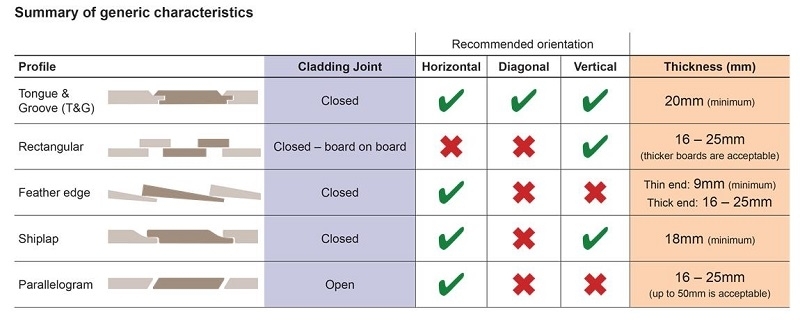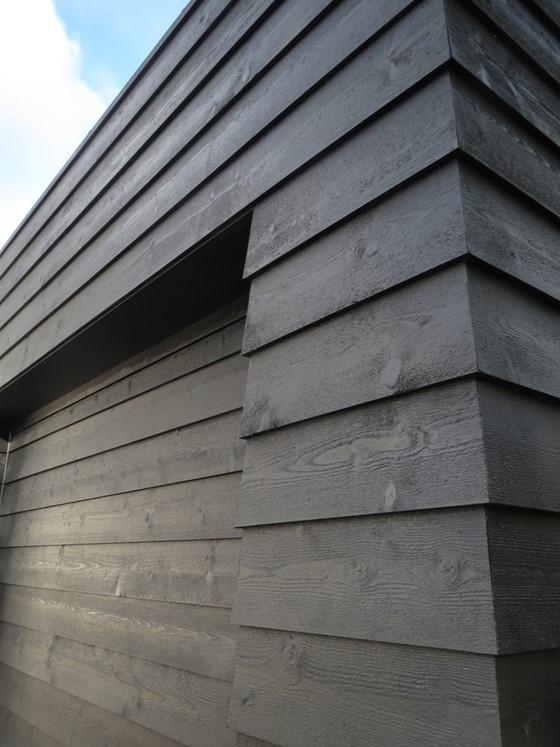Important cladding design considerations
Published: 04/11/20 By: Mike Bekin
With the versatility of timber cladding, there are several design aspects to take into account. Below we explore some of the important aspects to consider at the design stage of your latest build project.
Cladding design, think profile styles
Timber cladding can be installed in many configurations. It is important to choose the best profile style for the build exterior. Timber length also needs to be carefully considered – does your prefered timber species come in short or long lengths?.
Look at the area to be clad and the best orientation – will the timber cladding be horizontal, vertical, or diagonal.
There are several different profiles styles, including tongue and groove, rectangular, feather edge, shiplap, rhombus, and parallelogram.
Cladding joints for each of these options are closed, meaning less gaps, apart from parallelogram profile – where cladding joints are open, so rarely used.
Therefore, profile styles are something to consider with fluctuations in the weather and depending on project location.

There is a wide choice of standard profiles available in softwoods, modified woods, and hardwoods. Dimensions and styles can vary depending on your supplier.
At Ecochoice, we always suggest obtaining samples first and agree on quality parameters before confirming your selection.
Top tip: Refer to British Standard BS 8605, External Timber Cladding Part 1: Method of specifying. for guidance.
Only specify cladding manufactured under a recognised quality scheme such as the TDCA CladMark/ ISO09001. You can then feel confident in your choice and not need to worry about surprises later.
For more references, there’s also this cladding manual by Trada.
Ease of maintenance
Ease of access is important for maintenance, repair or replacing boards due to damage. So, consider the level of access at the design stage – this will save you time, cost and headaches if in the future you need to replace or repair any boards.
For example, if access is easy and the client is happy with regular maintenance costs then a wider range of options can be considered. In some cases, though access will be limited making maintenance harder, then timber with medium to high durability is a better option.
Minimising the impact of movement
as the weather changes wood will expand or contract. But did you know that moisture content of external timber cladding will fluctuate from around 12% in summer to 20% in winter – or after heavy rain? We recommend that for the large part, at the time of installation, timber cladding should have a moisture content of approximately 16%.
Therefore, the timber grade you choose and the way it is installed needs to consider temperature and humidity levels to allow for wood expansion and contraction.
Otherwise, the changes could result in gaps which will in turn compromise weather protective treatments and expose the under surface.
Performance and durability
The best timber performance and durability will come from the choice in material specification and subsequent attention to detail when installing your timber cladding.
The biggest issues seem to occur when cladding has been installed with the wrong moisture content compared to its environment, or when it has been installed or maintained badly.
In these cases, it’s not just the impact of water damage, it can also be breeding grounds for fungi, decay, and insects.
How to protect timber cladding?
-
Read our guide on maintaining cladding.
-
The better the natural properties, such as natural durability, the better protected the timber is.
-
For lower timber grades, with more sap, knots, shakes and cracks, it is recommended to use a good wood protection process to improve durability.
-
Use the appropriate coatings and finishes as specified.
-
Consider location when determining the timber choice.
-
Select the appropriate profile and timber direction.
-
Ensure the timber has the correct moisture level when installed.
-
Only use reputable builders and maintenance workers.
-
Ensure the timber complies to British Standards and adheres to fire protection laws with the correct fire retardant.
Here at Ecochoice, we can tick all of the above. If you would like to find out more about our exterior timber cladding options, please get in touch.
Call us on 0345 638 1340 – or drop us an email at sales@ecochoice.co.uk.
Images: TDCA
